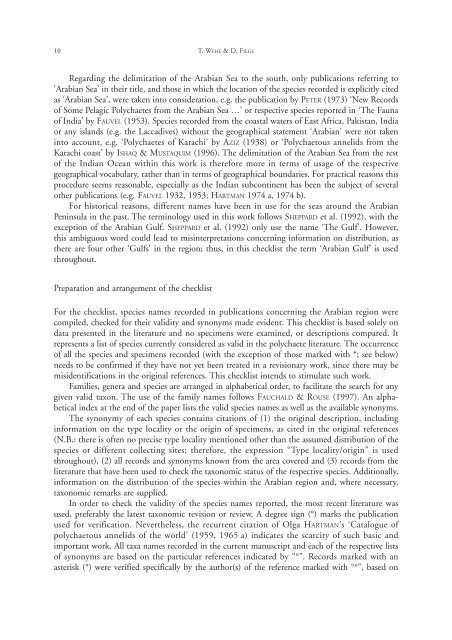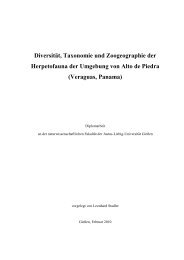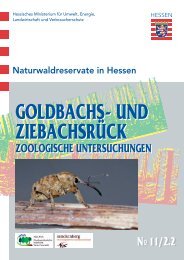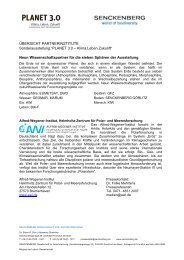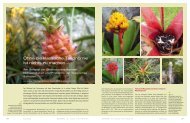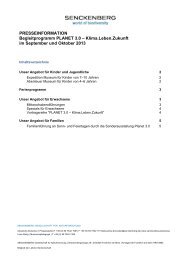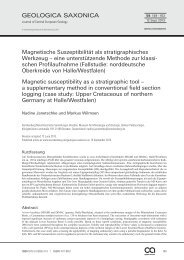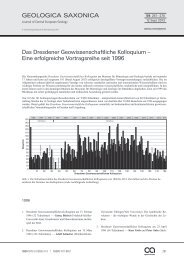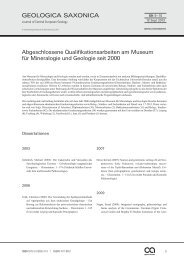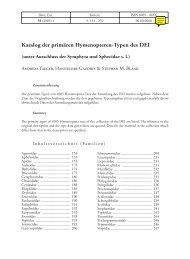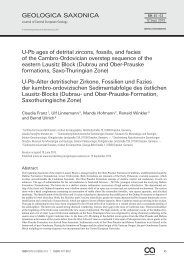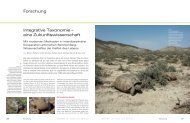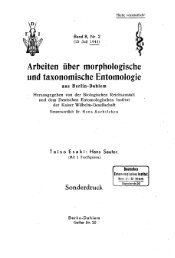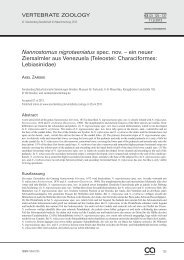Annotated checklist of the polychaete species of the ... - Senckenberg
Annotated checklist of the polychaete species of the ... - Senckenberg
Annotated checklist of the polychaete species of the ... - Senckenberg
Create successful ePaper yourself
Turn your PDF publications into a flip-book with our unique Google optimized e-Paper software.
10 T. WEHE & D. FIEGE<br />
Regarding <strong>the</strong> delimitation <strong>of</strong> <strong>the</strong> Arabian Sea to <strong>the</strong> south, only publications referring to<br />
‘Arabian Sea’ in <strong>the</strong>ir title, and those in which <strong>the</strong> location <strong>of</strong> <strong>the</strong> <strong>species</strong> recorded is explicitly cited<br />
as ‘Arabian Sea’, were taken into consideration, e.g. <strong>the</strong> publication by PETER (1973) ‘New Records<br />
<strong>of</strong> Some Pelagic Polychaetes from <strong>the</strong> Arabian Sea …’ or respective <strong>species</strong> reported in ‘The Fauna<br />
<strong>of</strong> India’ by FAUVEL (1953). Species recorded from <strong>the</strong> coastal waters <strong>of</strong> East Africa, Pakistan, India<br />
or any islands (e.g. <strong>the</strong> Laccadives) without <strong>the</strong> geographical statement ‘Arabian’ were not taken<br />
into account, e.g. ‘Polychaetes <strong>of</strong> Karachi’ by AZIZ (1938) or ‘Polychaetous annelids from <strong>the</strong><br />
Karachi coast’ by ISHAQ & MUSTAQUIM (1996). The delimitation <strong>of</strong> <strong>the</strong> Arabian Sea from <strong>the</strong> rest<br />
<strong>of</strong> <strong>the</strong> Indian Ocean within this work is <strong>the</strong>refore more in terms <strong>of</strong> usage <strong>of</strong> <strong>the</strong> respective<br />
geographical vocabulary, ra<strong>the</strong>r than in terms <strong>of</strong> geographical boundaries. For practical reasons this<br />
procedure seems reasonable, especially as <strong>the</strong> Indian subcontinent has been <strong>the</strong> subject <strong>of</strong> several<br />
o<strong>the</strong>r publications (e.g. FAUVEL 1932, 1953; HARTMAN 1974 a, 1974 b).<br />
For historical reasons, different names have been in use for <strong>the</strong> seas around <strong>the</strong> Arabian<br />
Peninsula in <strong>the</strong> past. The terminology used in this work follows SHEPPARD et al. (1992), with <strong>the</strong><br />
exception <strong>of</strong> <strong>the</strong> Arabian Gulf. SHEPPARD et al. (1992) only use <strong>the</strong> name ‘The Gulf’. However,<br />
this ambiguous word could lead to misinterpretations concerning information on distribution, as<br />
<strong>the</strong>re are four o<strong>the</strong>r ‘Gulfs’ in <strong>the</strong> region; thus, in this <strong>checklist</strong> <strong>the</strong> term ‘Arabian Gulf’ is used<br />
throughout.<br />
Preparation and arrangement <strong>of</strong> <strong>the</strong> <strong>checklist</strong><br />
For <strong>the</strong> <strong>checklist</strong>, <strong>species</strong> names recorded in publications concerning <strong>the</strong> Arabian region were<br />
compiled, checked for <strong>the</strong>ir validity and synonyms made evident. This <strong>checklist</strong> is based solely on<br />
data presented in <strong>the</strong> literature and no specimens were examined, or descriptions compared. It<br />
represents a list <strong>of</strong> <strong>species</strong> currently considered as valid in <strong>the</strong> <strong>polychaete</strong> literature. The occurrence<br />
<strong>of</strong> all <strong>the</strong> <strong>species</strong> and specimens recorded (with <strong>the</strong> exception <strong>of</strong> those marked with *; see below)<br />
needs to be confirmed if <strong>the</strong>y have not yet been treated in a revisionary work, since <strong>the</strong>re may be<br />
misidentifications in <strong>the</strong> original references. This <strong>checklist</strong> intends to stimulate such work.<br />
Families, genera and <strong>species</strong> are arranged in alphabetical order, to facilitate <strong>the</strong> search for any<br />
given valid taxon. The use <strong>of</strong> <strong>the</strong> family names follows FAUCHALD & ROUSE (1997). An alphabetical<br />
index at <strong>the</strong> end <strong>of</strong> <strong>the</strong> paper lists <strong>the</strong> valid <strong>species</strong> names as well as <strong>the</strong> available synonyms.<br />
The synonymy <strong>of</strong> each <strong>species</strong> contains citations <strong>of</strong> (1) <strong>the</strong> original description, including<br />
information on <strong>the</strong> type locality or <strong>the</strong> origin <strong>of</strong> specimens, as cited in <strong>the</strong> original references<br />
(N.B.: <strong>the</strong>re is <strong>of</strong>ten no precise type locality mentioned o<strong>the</strong>r than <strong>the</strong> assumed distribution <strong>of</strong> <strong>the</strong><br />
<strong>species</strong> or different collecting sites; <strong>the</strong>refore, <strong>the</strong> expression “Type locality/origin” is used<br />
throughout), (2) all records and synonyms known from <strong>the</strong> area covered and (3) records from <strong>the</strong><br />
literature that have been used to check <strong>the</strong> taxonomic status <strong>of</strong> <strong>the</strong> respective <strong>species</strong>. Additionally,<br />
information on <strong>the</strong> distribution <strong>of</strong> <strong>the</strong> <strong>species</strong> within <strong>the</strong> Arabian region and, where necessary,<br />
taxonomic remarks are supplied.<br />
In order to check <strong>the</strong> validity <strong>of</strong> <strong>the</strong> <strong>species</strong> names reported, <strong>the</strong> most recent literature was<br />
used, preferably <strong>the</strong> latest taxonomic revision or review. A degree sign (°) marks <strong>the</strong> publication<br />
used for verification. Never<strong>the</strong>less, <strong>the</strong> recurrent citation <strong>of</strong> Olga HARTMAN’s ‘Catalogue <strong>of</strong><br />
polychaetous annelids <strong>of</strong> <strong>the</strong> world’ (1959, 1965 a) indicates <strong>the</strong> scarcity <strong>of</strong> such basic and<br />
important work. All taxa names recorded in <strong>the</strong> current manuscript and each <strong>of</strong> <strong>the</strong> respective lists<br />
<strong>of</strong> synonyms are based on <strong>the</strong> particular references indicated by “°”. Records marked with an<br />
asterisk (*) were verified specifically by <strong>the</strong> author(s) <strong>of</strong> <strong>the</strong> reference marked with “°”, based on


